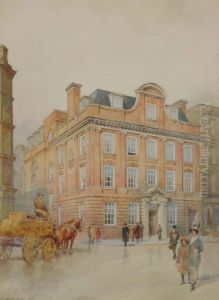Arthur Conran Blomfield Paintings
Arthur Conran Blomfield, born in Fulham, London, on 6 March 1829, was a distinguished English architect who left a significant mark on the architectural landscape of Victorian England. The son of Charles James Blomfield, the Bishop of London, Arthur was steeped in a milieu that valued both intellectual and aesthetic pursuits from a young age. He was educated at Rugby and later went on to study at Trinity College, Cambridge, where he nurtured his deep interest in architecture. After Cambridge, he trained under Philip Charles Hardwick, a prominent architect of the time, and became a member of the Royal Institute of British Architects (RIBA) in 1856. Blomfield's career was a testament to his versatility and his ability to adapt to the architectural needs and styles of his era.
Throughout his career, Blomfield designed a wide variety of buildings, including churches, schools, hospitals, and residential buildings, demonstrating a mastery over Gothic revival architecture, a style that sought to revive medieval Gothic architectural forms. One of his most notable works is the Royal College of Music in London, completed in 1894, which is considered a masterpiece of Victorian architecture. He was also involved in restoration projects, such as the one for the Southwark Cathedral in London, showcasing his skill in preserving and enhancing historical structures with sensitivity and creativity.
Blomfield's contributions to architecture were recognized by his peers and the broader society. He was awarded the Royal Gold Medal by the Royal Institute of British Architects in 1891, a prestigious accolade that underscored his significant impact on the architectural profession. In addition to his professional accomplishments, Blomfield was an active member of the architectural community, serving as president of the RIBA from 1896 to 1899. His legacy is not only seen in the buildings he designed but also in his influence on the generation of architects who followed him.
Arthur Conran Blomfield passed away on 30 October 1899, leaving behind a rich portfolio of architectural works that continue to be celebrated for their design excellence and historical significance. His dedication to his craft and his ability to blend functionality with aesthetic beauty remain inspirational to architects and designers. Blomfield's work contributed significantly to the architectural heritage of Britain, making him a pivotal figure in the history of Victorian architecture.
